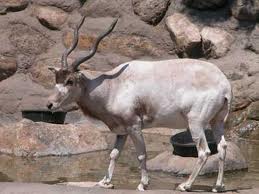
Addax
Addax nasomaculatus
Hmotnost
221 - 276 lbs ( 100 - 125 kg)
Výška
47 - 51 inches ( 120 - 130 cm)
About Addax
The addax also known as the screwhorn antelope, is an antelope of the genus Addax, that lives in the Sahara desert. It was first described by Henri Blainville, a French zoologist and anatomist, in 1816. As suggested by its alternative name, this pale antelope has long, twisted horns. It is closely related to the oryx, but differs from other antelopes by having large square teeth like cattle and lacking the typical facial glands.
It mainly eats grass, and leaves of any available shrubs, leguminous herbs and bushes. These animals are well-adapted to exist in their desert habitat, as they can live without water for long periods of time. Addax form herds of five to twenty members, consisting of both males and females. They are led by the oldest female. Breeding season is at its peak during winter and early spring. The addax can be easily hunted by its predators due to its slow walking pace. The natural habitat of addax are arid regions, semideserts and sandy and stony deserts.
The addax inhabits arid regions, semideserts and sandy and stony deserts[7], but today are only found in rare pairs or as individuals in the Sahara desert and a few neighboring regions. The addax is extinct in Jordan since 1900 and in Egypt and Morocco by the mid-20th century. It was once abundant in north Africa, native to regions like Chad, Mauritania and Niger. Fossils are known from Egypt, Morocco, Algeria, and Sudan, dating back to the Pleistocene.[3]
By 1972, the addax was found mainly in Rio de Oro, Mauritania; north Mali and Chad; with some in Algeria, South Libya, and North Sudan. It was rare everywhere except in the uninhabited area in Mauritania and Mali in the western Sahara. It is now found in scarce populations in Mauritania, Mali, Chad, Niger and almost extinct in Sudan, Algeria, Egypt, Libyan Arab Jamahiriya and western Sahara.
Some addax are to be found on game ranches in Texas where they are raised for trophy hunting.
